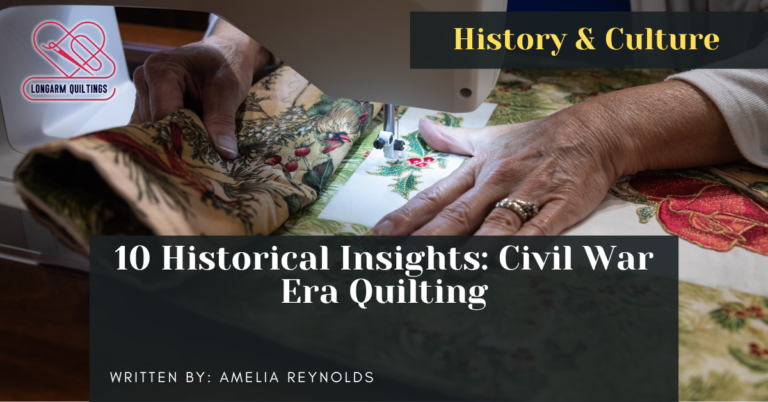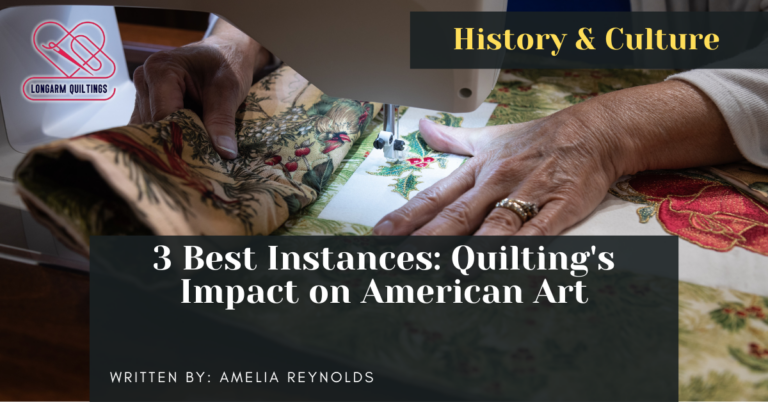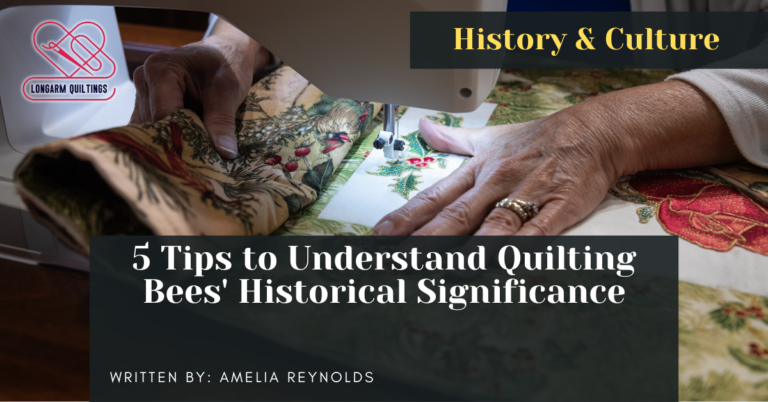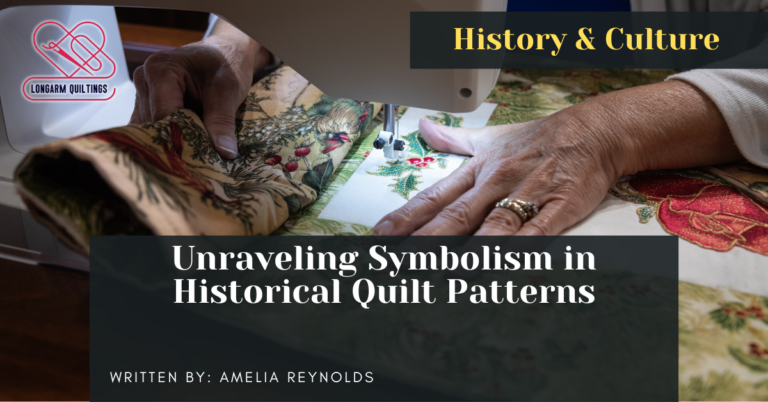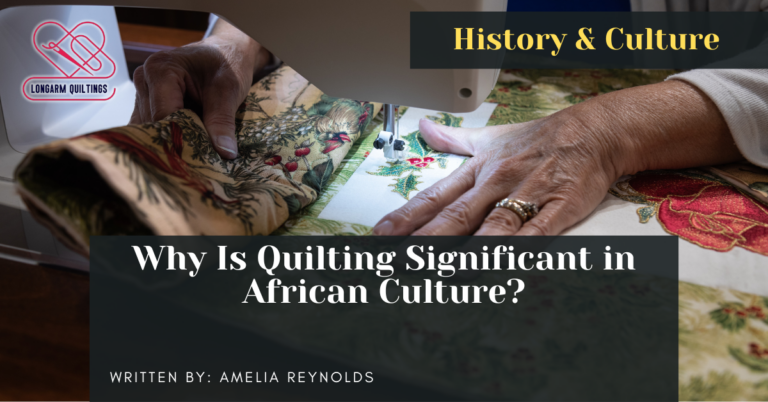In the world of quilting, certain pieces transcend their purpose as mere fabric and thread constructs, weaving narratives that encapsulate historical events and personal stories.
The Civil War Quilt, with its intricate patterns and hidden messages, tells a tale of resilience amidst turmoil.
The Underground Railroad Quilt serves as a symbol of hope and solidarity during a dark chapter of American history.
Lastly, the Family Heirloom Quilt not only provides warmth but also carries within its stitches the memories and legacies of generations past.
Each of these quilts holds within its fibers a captivating story waiting to be discovered.
The Civil War Quilt
During the tumultuous era of the Civil War, quilts served as both practical items and poignant symbols of resilience and unity among American communities. These quilts were not merely blankets but intricate pieces of art, often incorporating hand-sewn details that showcased the skill and dedication of their creators. Quilt patterns during this time were more than just designs; they held hidden meanings and messages for those who understood them.
The Civil War quilt patterns were rich in symbolism. For example, the 'Log Cabin' pattern represented the idea of home and hearth, offering comfort to those who had been displaced by the war. The 'Monkey Wrench' pattern symbolized the tightening tensions of the war, while the 'North Star' provided hope and guidance for those seeking freedom and safety.
Through these carefully crafted quilt patterns and the laborious process of hand-sewing each piece together, women especially found a way to express their support for the war efforts, commemorate fallen soldiers, and maintain a sense of unity in a fractured nation. The Civil War quilts remain a testament to both the artistry and the resilience of the American people during one of the nation's most challenging periods.
The Underground Railroad Quilt
Symbolizing defiance and hope, the Underground Railroad Quilt stands as a poignant testament to the courage and ingenuity of those seeking freedom during a tumultuous period in American history. The quilt's intricate patterns served as a form of secret communication among individuals involved in the Underground Railroad network, a clandestine system aiding enslaved individuals in their quest for freedom.
Each quilt block held specific meanings, offering hidden messages to guide escapees on their journey towards liberation. For instance, the North Star symbolized the direction to follow, the Monkey Wrench indicated to gather tools for the journey, and the Bear's Paw warned of danger ahead. These coded symbols allowed quiltmakers to pass on vital information discreetly, safeguarding the identities of those involved and preventing interception by slaveholders.
The Underground Railroad Quilt not only represents the resilience of those fighting for freedom but also showcases the power of symbolism and covert messaging in historical contexts of resistance and liberation.
The Family Heirloom Quilt
The preservation and passing down of the Family Heirloom Quilt signifies a cherished tradition deeply rooted in generational storytelling and craftsmanship. Family Heirloom Quilts are not just pieces of fabric sewn together; they are intricate tapestries of family history and love. These quilts hold immense sentimental value and are often treasured for generations to come. To ensure their longevity, families employ various preservation techniques such as proper storage in acid-free materials and regular cleaning to prevent deterioration.
The delicate hand-stitched patterns narrate stories of the past, connecting each family member to their ancestors.
The restoration process of a Family Heirloom Quilt is a meticulous task that requires expert care to maintain its authenticity and beauty.
Each patch and seam carries the weight of the family legacy, making the quilt a symbol of resilience and unity.
Family Heirloom Quilts serve as tangible artifacts of familial bonds, weaving together memories and traditions into a single, timeless masterpiece.
Frequently Asked Questions
How Did Quilting Techniques Evolve Over Time in Different Regions of the World?
Quilting techniques have evolved over time due to cultural influences in different regions worldwide. The evolution of quilting reflects the diverse traditions and materials available, resulting in unique styles and methods that showcase the rich history of textile craftsmanship.
What Role Did Quilts Play in Women's Activism and Empowerment Throughout History?
Quilts have served as powerful tools in women's activism, showcasing their creativity and resilience. Through quilting techniques passed down through generations, women have used quilts to convey messages, share stories, and advocate for change.
Are There Any Famous Quilts That Have Been Lost or Destroyed Over the Years?
Lost treasures and forgotten masterpieces abound in the history of quilting. Famous quilts that have been lost or destroyed over the years evoke a sense of mystery and longing, leaving gaps in the narrative of this intricate craft.
How Have Modern Technologies and Materials Changed the Art of Quilting?
Innovative techniques and sustainable materials have revolutionized the art of quilting. Modern technologies like computerized design software and high-tech sewing machines enable intricate patterns and precise stitching. Environmentally friendly fabrics enhance both aesthetics and sustainability in contemporary quilting practices.
What Is the Process for Authenticating and Preserving Historical Quilts for Future Generations?
Authentication process for historical quilts involves thorough research, including provenance verification, material analysis, and historical context assessment. Preservation techniques encompass proper storage, climate control, and conservation methods to ensure these artifacts endure for future generations.
Conclusion
In conclusion, historical quilts such as The Civil War Quilt, The Underground Railroad Quilt, and The Family Heirloom Quilt provide valuable insights into the social, cultural, and political contexts of their time periods.
Through their intricate designs and fascinating stories, these quilts serve as important artifacts that showcase the creativity, resilience, and connections of individuals throughout history.
Studying these quilts can offer a deeper understanding of the past and the significance of textile art in preserving memories and traditions.

